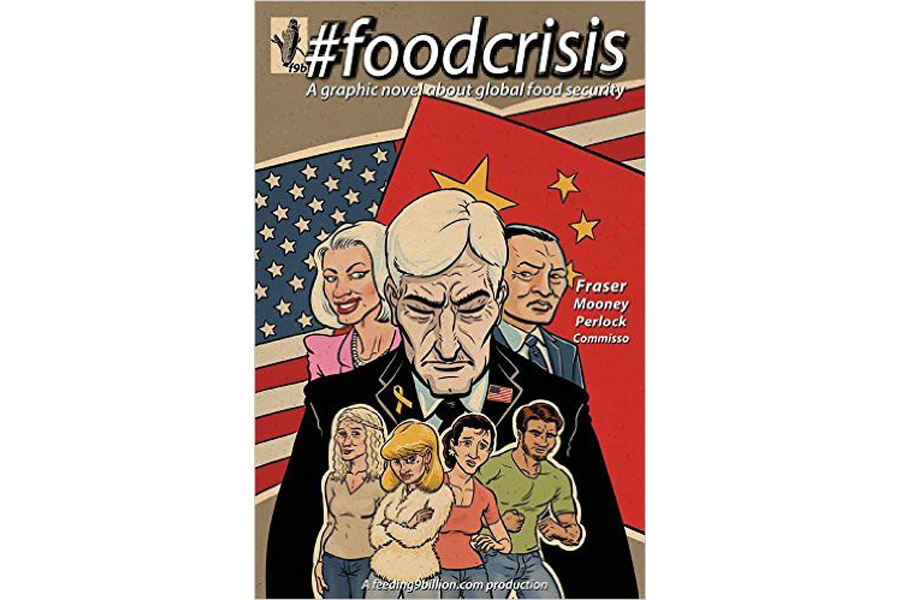Ten delicious culinary comics
Loading...
Comics and graphic novels can be an entertaining medium through which to learn about the many ways food intersects with all facets of life. This list of 10 comics and graphic novels from culinary celebrities, comic writers, artists, and a vintner, highlight different relationships people can have with their food. With protagonists including police officers, chefs, artists and the average eater, it is no surprise, then, that readers are eager to dig into food-centered comics.
#foodcrisis By Evan D.G. Fraser
This graphic novel webzine represents a dramatization of Fraser's concerns for the present food regime. Set in the year 2025, global droughts and volatile food prices see financial institutions benefiting with no government intervention. The response is violent, with the threat of revolution pending. Striking illustrations act as the backdrop for a more academic narrative, which delves into the systemic inequalities that perpetuate hunger.
Chew By John Layman and Rob Guillory
Expanding upon the work of MFK Fisher, who connects food and memories in her writings during the 1930s to 1990s, Layman and Guillory have created a begrudging hero: a police officer who has cibopathic abilities, allowing him to sense the history of whatever he eats. While limiting his palate, this secret ability does not hinder his appetite to fight crime in the streets of Philadelphia.
Get Jiro! By Joel Rose, Anthony Bourdain, and Langdon Foss
Set in a near-future dystopia, Bourdain and Rose tell the story of Jiro, a sushi chef determined to pursue his craft despite conscripted service to his father's mob affiliations. Dynamic art showcases a food-obsessed L.A, where disrespecting good food could get a person killed. A sequel to this 2012 title was released October 2015.
The Initiates: A Comic Artist and a Wine Artisan Exchange Jobs By Étienne Davodeau
This breathtaking black and white graphic novel documents an unorthodox job-exchange between a comic artist and a vintner. The book is a visual journal of the experience, treating readers to a thorough education of growing and harvesting grapes, comics, and comic artists while deepening their appreciation of craftsmanship.
Jughead, Issue 1 By Chip Zdarsky and Erica Henderson
As part of a line-wide reboot of Archie Comics, Jughead offers a refreshingly modern style and tone, combined with the classic characters we know and love. In this particular issue, the main character confronts a new, authoritative principal who has removed the favorite hamburger from the cafeteria menu. This act prompts Jughead to delve into the world of home economics and home cooking and causes the readers to delight in his culinary abilities.
Oishinbo: The Joy of Rice By Tetsu Kariya and Akira Hanasaki
Part of a larger series of manga featuring journalist Yamaoka, this particular issue reads more like a cooking reality show. Two competing newspapers aim to showcase the ultimate Japanese meal, with their journalists going to extreme lengths to find unique ingredients. Challenging class assumptions and the privilege associated with being a gourmet, Kariya and Hanasaki show a profound respect for their art and the art of cooking well.
Relish: My Life in the Kitchen By Lucy Knisley
Knisley combines memoir, travelogue, and recipe book packaged beautifully in her crisp artwork. The daughter of a chef and a gourmet, this graphic novel encapsulates the relationship we have with those we break bread with, and the bread itself.
Rutabaga, the Adventure Chef By Eric Colossal
This adorably illustrated collected webcomic follows the quest of chef Rutabaga and his caldron sidekick, Pot. Set in a Lord of the Rings-type world, this duo is determined to travel the land, searching for magic ingredients to include Rutabaga's cookbook. The book captures the excitement of expanding one's palate, and readers will see Rutabaga's propensity for getting into trouble and his consistent ability to cook his way out of it.
Starve By Brian Wood and Danijel Zezelj
This series, set in a dystopian future, sees disgraced chef Gavin Cruickshank respond to the commodification of food by those able to afford it while attempting to build a relationship with his estranged daughter. Following a televised cooking show, in which Cruickshank is a contestant, readers will be simultaneously perturbed and drawn to the grittiness of such a future and the art of Zezelj.
What did you eat yesterday? By Fumi Yoshinaga
Exploring themes such as gender roles and sexual identity, Yoshinaga has lovingly provided readers a peek into the life of lawyer Shiro, and his partner Kenji in this series. Tantalizing images of traditional Japanese fare combine with inner monolog, providing further information on recipes, and observations on the role of food in our relationships.
This article first appeared at Food Tank.







